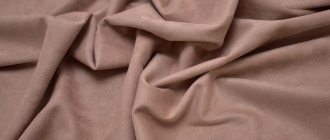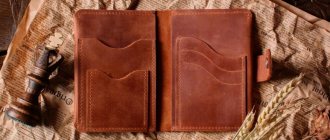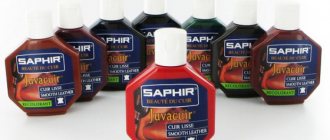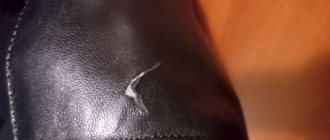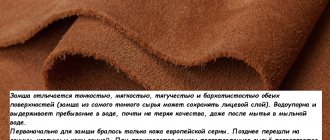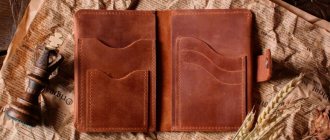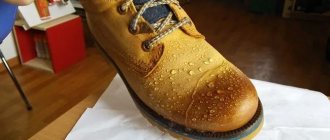What is pressed leather
For clarity, this type of material can be compared with sausage products. A homogeneous fabric is formed from various substandard and very small residues, waste from the production of goods from whole natural leather, and often the same pressed under very high pressure.
The connection of the components occurs through the use of synthetic binder fibers (polyester, polyethylene, polyamide, etc.). When exposed to high temperatures, they melt, which ensures the adhesion of small natural particles.
Synthetic thermoplastic resins are also used in production. Their function is to ensure more reliable gluing of the components and make the structure of the canvas more uniform, and the material itself stronger.
However, these same qualities significantly reduce the moisture and breathability of pressed leather. And if lower moisture conductivity is preferable in some cases, then the lack of the ability to “breathe” can definitely be attributed to the disadvantages of the material when sewing clothes and shoes. In addition, the strength of products made from a material formed from many small components is low and is significantly inferior to its natural counterpart.
Advantages
Pressed leather is used to make shoes and outerwear. Various accessories are popular: bags, backpacks, purses, purses, wallets, business card holders, belts, covers for documents and diaries. Can be used to cover furniture. It is combined with other materials . A number of designers willingly use pressed leather and display it in their collections.
- Externally it does not differ from genuine leather.
- Looks aesthetically pleasing.
- Does not require complex care.
- Low moisture permeability.
- Pores of equal depth and shape.
- Smooth sealed edges.
- Used to make clothing, shoes and accessories.
- Affordable price.
Products made from high-quality material look presentable, but will only last a couple of seasons. A special problem is places of constant load (bends, holes in belts), which quickly become deformed and break .
Disadvantages of pressed fabric products
Pressed leather is not suitable for making all products. And this is without taking into account the increased “harmfulness” of its production - the use of chemical resins, synthetic fabric components and high temperatures is negative for everyone involved in the manufacturing process. Add to this the frequent non-compliance with production safety rules and the lack of necessary environmental protection measures.
Bags, belts and other accessories, interior items made from pressed leather will be less durable, soft and elastic than natural ones, but given the difference in cost, you can live with this, and the low price can even be called a significant advantage.
As for clothing, and especially shoes, low breathability and moisture-conducting ability can lead to excessive sweating, increased fatigue, and diseases of the lower extremities and kidneys. In addition, such shoes, when actively worn, quickly lose their original shape and may crack or burst at the bends.
Other types
There are a lot of technologies and varieties of imitation production. They are all similar in that synthetic additives, polymers and chemicals are used to create the sheets. Below we describe the main types of substitutes and more, as well as their main features.
Vinyl leather
This is a completely synthetic fabric, which is created using a similar technique. For production, artificial fibers and polyvinyl chloride are used as the base. First, the base is prepared - a mixture of fibers and PVC, and then the layers are rolled out, painted, coated with polymers and given an aesthetic appearance to the material. This is not the most durable option, but it is inexpensive and common in the manufacture of shoes, bags and other accessories.
Boiled
This is not an artificial substitute, but natural leather, which is tanned under special conditions, due to which it turns out incredibly soft and beautiful. Ordinary animal skin is exposed to high temperatures - it is placed in glue, boiled in water, and then plant resins, oils, and wax are used. This is not the end of the processing procedure, since several more technological steps follow after this.
After the previous stages, the skin goes through the stage of fatliquoring, dyeing and final drying. Some types of “varenka” then undergo a stage of decorative processing. Due to the fact that the creation method is so complex and labor-intensive, the cost of finished goods is many times higher.
Stamped
The stamping technique is used for decoration and creating beautiful designs. This variety is also called morocco; the cost of stamped goods is higher, not only because of the presence of additional decor, but also because of the high complexity of production.
To create real masterpieces, sheep, goat or calf leather is used as the most pliable and elastic option. The technique of creating beautiful patterns on canvas is complex and requires special skill. First, the raw material is tanned, then processed and patterned, after which it is painted and coated with special compounds that secure the result. Ready-made sheets of fabric are used to create branded accessories, shoes and clothing.
Textured
This type is great for creating stylish leather items with texture or patterns on the surface. At the preparation stage, the layer is embossed, due to which the surface becomes textured. Additionally, painting using a special technology can be used to create a patina effect or highlight the texture.
For such purposes, a natural base is also most often used, but similar technology is often used to process high-quality substitutes. The finished canvas turns out to be as similar in appearance to natural raw materials as possible, due to which it looks aesthetically pleasing and attractive.
Printed
Printing technology was invented a long time ago, but in modern industry it has gone through a number of metamorphoses. Due to this, you can create any patterns and designs on the surface so that they do not fade or lose their brightness over time. High-quality printed fabric looks very stylish and can be used to create original branded items and accessories. The complexity of production technology increases the cost of raw materials, which means that the price of finished accessories, shoes and clothing made from such raw materials will be many times higher.
Recycled
Recycled leather is created using the same technology as press leather, but latex is used as an adhesive base rather than polymers. This makes the finished material more practical, elastic and durable. Service life and cost are slightly higher.
Latex is a natural substance, which means the finished product is as environmentally friendly as possible. To find out the composition, you should ask the seller or read the information provided on the label of the item.
How to distinguish pressed leather from genuine leather
One of the easiest ways is to read the product description:
- in English, genuine leather will be called genuine leather,
- in Italian - vera pelle,
- French manufacturers will write cuir,
- The Germans call it echtleder.
It is also useful to consider special symbols indicating what material the product is made from. Materials of artificial origin are marked with a classic rhombus, while natural ones are marked with a figured one, roughly reminiscent of stretched skin.
However, often such a label is missing, or there is a chance of encountering an unscrupulous manufacturer providing incorrect information.
You should immediately exclude such long-known recognition methods as smell and the possibility of combustion from being 100% reliable. After all, modern technologies make it possible to impregnate artificial analogues with natural leather flavoring; moreover, many types of synthesized fabric no longer melt, but are charred, like natural materials. And not every seller will allow the buyer to check the quality of the goods offered with the help of fire.
Application in production: shoes and bags
The use of a pressed composite instead of a natural analogue is a common practice. But this leather is most actively used for shoes - insoles, heels, inner lining. It is not recommended to use it as a top, as it does not have sufficient strength.
Thanks to the rich palette of shades and textures, it has become a godsend for the production of accessories. Composite material is used to make bags, wallets, clutches, belts, and jewelry. The products are inexpensive, but look no worse than branded ones, so they always find their buyer.
Inspection check
The source of the main part of external information for the vast majority of people is vision. Upon examination, the difference between pressed leather and natural leather can be identified in the following ways:
- Bend the product - if it is shoes, it is better in the toe area. Or press the skin quite firmly with your fingers - if it is natural, then the small folds and wrinkles that appear during this process should disappear without a trace as soon as the product straightens.
- Also, when changing the shape of the material, you should pay attention to its color in this place - it changes with natural leather. However, this method of testing is not suitable for one of the most popular colors - black.
- Seam finishing. Manufacturers of products made from natural materials not only do not try to hide what the product is made of, but on the contrary, they strongly emphasize this advantage. Therefore, the seam sections of genuine leather products, unlike pressed ones, are usually left open - not processed or folded.
- The reverse side of genuine leather will be fleecy and suede-like. Leatherette is often smooth, in most cases it has a textile base. However, it can simply be glued onto suede or its imitation.
- The pores on the front surface of natural leather, unlike pressed leather, will be located in the same direction, look similar and organic, but not identical, without repeating the pattern multiple times. In order to avoid groundless suspicions of deception, one should not forget that natural leather is not uniform in its natural color. Therefore, in some cases there may be areas of different tones and shades on it. When identifying the origin of a material, you should pay attention to its structure.
Types of leather substitutes
There are materials that are similar to leather in structure and appearance, but are not leather. They are called leatherettes.
Leatherette is an artificial material that creates the appearance of natural leather . It consists of several layers. Leatherette is used in various fields of production. Most artificial substitutes can hardly be distinguished from natural material: they withstand moisture and frost. Leatherette is popular because it is inexpensive, practical and durable .
Types of leatherette: How to distinguish
- Vinyl leather is a durable material, has good elasticity, is prone to draping, and completely imitates natural matter;
- Dermantin is an artificial material. It is resistant to abrasion, has a slight odor, and is cheap;
- Eco-leather is a soft material, resistant to wear, breathable, has good elasticity, does not crack, does not smell.
Features of eco leather
Few people know what eco-leather is on shoes and how to distinguish eco-leather from genuine leather. Eco-leather is made from a cotton base, on which is applied : it imitates natural matter, and thanks to the base, the material becomes resistant to abrasion, stretching and tearing.
Its main advantage is that it is environmentally friendly (hence the name), because no animal is harmed during its production, and during use it does not emit harmful substances into the air. It is hypoallergenic. This material is resistant to moisture and does not let it in, but at the same time the foot breathes in it. And in shoes made of eco-leather you will be comfortable in all weather conditions. It creates a complete imitation of natural matter, costs less than leather products, but also lasts a long time.
Moisture test
Not every seller will allow you to wet a product you haven’t purchased, but you should still have a similar method of figuring out how to distinguish pressed leather from natural leather.
If moisture gets on natural leather that has not been treated with special water-repellent compounds, the material will absorb drops and in most cases darken (depending on the color of the product). The pressed analogue will do neither one nor the other.
No one should buy "leather" furniture if they don't understand the difference.
Most consumers buy leather furniture because they believe it will be extremely durable. And they are ready to pay for it. But in the end they don't get what they are looking for.
Artificial leather, where a layer of vinyl and polyurethane foam is applied to a specially selected fabric base, is a much more durable material than supposedly natural “glued leather”.
The use of the term "leather" to describe products made from bonded leather is already prohibited by law in some other countries.
If you buy glued leather furniture that starts to peel, retailers generally won't be held responsible.
- This type of problem is specifically excluded from both the seller's and manufacturer's warranties, unless you are "lucky" enough to have your furniture begin to peel after less than a year.
- The extended warranty never covers damage from peeling or cracking of bonded leather.
At this point, all you can do is sue the seller.
There have been many lawsuits regarding bonded skins that began to peel off after a short period of time. Consumers never win in such cases. Honest artificial leather costs (with the exception of some special materials) cheaper than semi-natural surrogates. Eco-leather also has predictable tensile strength and abrasion strength.
Tactile sensations
One of the main distinguishing features of genuine leather is its ability to absorb heat. If you hold it in your hands for a while, it will heat up from the temperature of the human body.
There is also the concept of “fullness” of the material - softness and elasticity; the difference in response to pressure and touch will be noticeable and very obvious.
Smell
As mentioned earlier, this method is not indisputable, especially if you focus on natural aroma. However, the synthesized fabric often has a pronounced chemical odor, pungent and unpleasant. Based on this characteristic, it is not difficult to distinguish pressed leather from natural leather. No matter how long the products that initially have such a smell are aired, a slight trace of it will still remain, and it can be noticed by bringing the product directly to the nose.
External similarities and differences
Without knowing what composite leather is, it can easily be called natural. Even in sections it repeats the characteristic structure. But it differs in properties:
- Breathability. Since the fabric is compacted by pressing or glued, it is less breathable.
- Strength. Inferior to natural ones, therefore shoes made entirely of composite wear out in a maximum of a couple of years during normal use.
- Hygroscopicity. If the technology involves the use of synthetic binders, the structure does not absorb water well.
- Elasticity. It doesn't stretch at all, it can only tear.
The price of the material is cheaper than natural, but more expensive than artificial substitutes. Usually in the marking on the product label the composition is indicated as “K. leather”, sometimes the designation is applied to the product or label in the form of an image or embossing.
Outerwear made from compressed material
The advantages of shoes made of genuine leather are obvious, but what can be said about outerwear?
Cloaks, skirts, trousers and jackets made of pressed leather often look very attractive and dignified. The decision to purchase and use them is best made based on factors such as the amount of money available to purchase the product; how the purchased item will be used in the future; characteristics of a particular human body.
If leather clothing is intended for active, constant wear and there is a desire to use the item for a long time, then if finances are limited, it may make sense to save up for a product made of genuine leather. You can take a closer look at the assortment of natural materials that are not of the highest class - a little more coarsely processed or made from less expensive raw materials (the skins of different animals can have a huge difference in cost).
However, if the item is trendy, designed for one season, or this outfit is rarely in demand in the wardrobe - perhaps it is needed solely for a beautiful photo - pressed leather will allow you to achieve your goal at an affordable price, without having any negative impact on the body.
What is the main danger of surrogates for the consumer?
Experience shows that 50% of clients who plan to acquire leather furniture do not know the difference between natural leather, artificial leather, and semi-natural (glued) leather.
The term "glued skin" is used to refer to surrogates and is easily misleading.
Companies that produce household furniture often try to disguise its use. Sellers of small personal items such as purses, belts, purses, etc. are even more at ease with these matters. The term "real leather" is almost universally used as a substitute for "bonded leather" for accessories. (This is why the "skin" on inexpensive accessories now peels off after a few months.)

